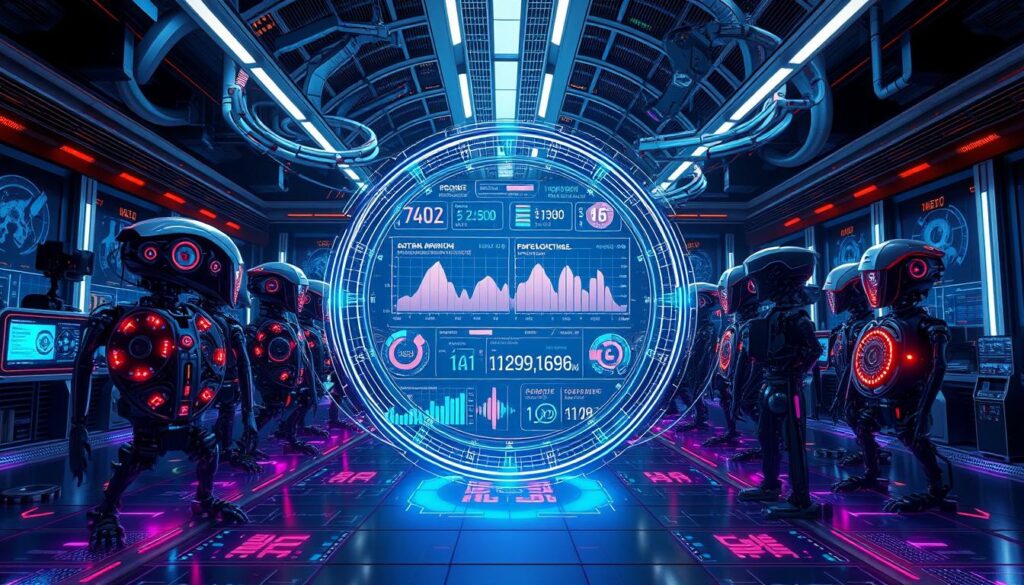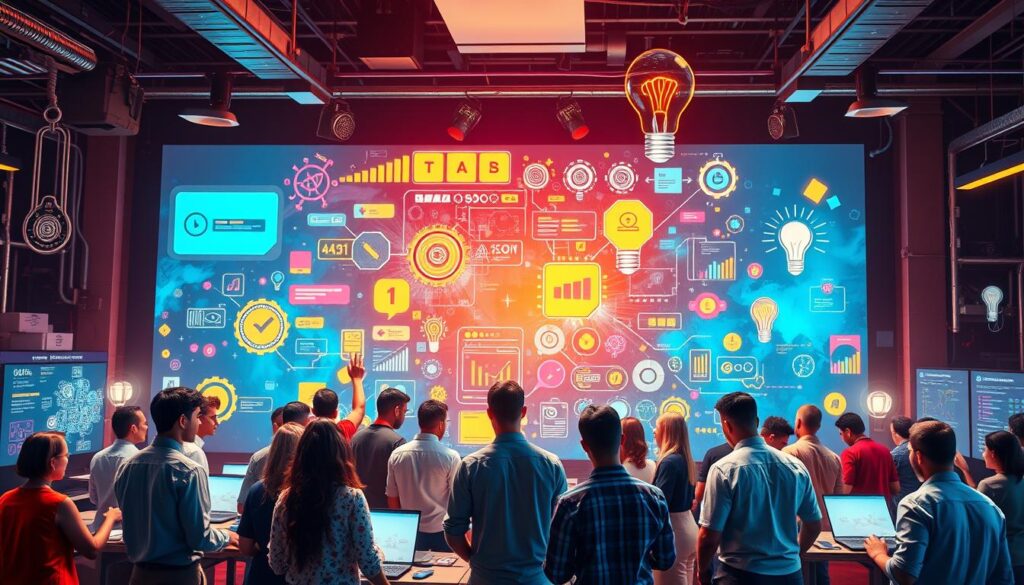“The greatest danger in times of turbulence is not the turbulence; it is to act with yesterday’s logic.” – Peter Drucker. This quote highlights the rapid changes in technology, especially in artificial intelligence. It raises questions about the true meaning of intelligence in our digital world.
Exploring whether ChatGPT is intelligent sparks a wider debate in the tech world. Large language models, like ChatGPT, face criticism for their inability to solve completely new problems. This calls for a detailed examination of their frameworks and functionalities1. With over 175 billion parameters, ChatGPT is one of the fastest-growing AI applications, attracting over a million users quickly2. Yet, these numbers prompt us to ask: Is this intelligence, or just a simulation of human conversation?
As AI becomes more prevalent, understanding ChatGPT’s capabilities and limitations is essential. Whether it marks a significant step toward artificial general intelligence (AGI) or is just a sophisticated tool is still up for debate1. This article aims to explore the essence of intelligence and where ChatGPT stands in the evolving AI landscape.
Key Takeaways
- The concept of intelligence is evolving with advancements in AI technology.
- Debates persist on whether ChatGPT’s capabilities truly qualify as intelligence.
- ChatGPT’s usage and engagement highlight its growing influence in various sectors.
- Understanding AI limitations helps clarify distinctions between human and machine intelligence.
- The release of advanced models stimulates broader discussions about the future of intelligent systems.
Understanding the Concept of Intelligence
The concept of intelligence is complex, with various definitions and frameworks. It goes beyond just cognitive skills, including emotional and social aspects. Howard Gardner’s theory on types of intelligence is well-known, listing several distinct intelligences like linguistic, logical-mathematical, and spatial.
Definition of Intelligence
Intelligence is more than just problem-solving and reasoning. It also involves emotional intelligence, which is crucial. This broader view shows how people can show their cognitive strengths in different ways.
Different Types of Intelligence
Howard Gardner’s Multiple Intelligences theory sheds light on the types of intelligence. He identifies eight, including interpersonal, intrapersonal, and musical. Each type has unique qualities that enhance human potential. People excel in different areas, proving intelligence is not one-size-fits-all.
Artificial Intelligence vs. Human Intelligence
The comparison between artificial intelligence and human intelligence is fascinating. AI systems like ChatGPT can perform well in tasks like standardized tests. For instance, ChatGPT excels in subjects like chess and radiology3. However, AI lacks true understanding and consciousness. Human intelligence is richer, with emotional depth and experiential learning that AI can’t replicate. ChatGPT’s data-driven nature raises questions about its intelligence45.
The Mechanisms Behind ChatGPT

The technologies driving ChatGPT are key to its success. At its core is the Natural Language Processing model. This model allows machines to understand and create human language, essential for giving clear answers.
Natural Language Processing Explained
Natural Language Processing (NLP) is the basis for ChatGPT’s query handling. It’s trained on a wide variety of texts, including books and articles. This training helps it grasp context and language subtleties. It captures vast amounts of data, thanks to billions of parameters during training6.
The model goes through a two-stage process. The first stage, pre-training, lets it learn language patterns without specific outputs. This stage is crucial for understanding language structure7.
Machine Learning Basics
Machine learning is vital for ChatGPT’s abilities. It uses unsupervised pretraining to learn text organization and language patterns. Then, supervised learning refines it on a smaller dataset, making it more responsive to user queries7.
This method ensures the model’s reliability and precision. It tailors responses to meet user needs effectively.
The Role of Neural Networks
Neural networks boost the Natural Language Processing model’s capabilities. ChatGPT employs a transformer architecture for understanding and generating text. This architecture is robust for language comprehension and text creation8.
Moreover, ChatGPT gets better with user feedback through Reinforcement Learning from Human Feedback (RLHF). This approach helps address issues like dishonest or biased responses. It ensures the output reflects human values more accurately8.
Evaluating ChatGPT’s Capabilities
ChatGPT’s capabilities can be analyzed through its strengths in language comprehension, contextual understanding, and creative output. These aspects are crucial for a comprehensive ChatGPT performance evaluation.
Language Comprehension
ChatGPT’s language understanding is reflected in its ability to engage with diverse prompts effectively. Advanced models like ChatGPT are trained on vast amounts of text, enabling them to generate coherent and contextually appropriate responses. For instance, in practical scenarios akin to the Turing Test, ChatGPT demonstrated its skill by interpreting a complex joke and providing a detailed explanation, which highlighted its sophisticated language processing capabilities9. However, despite this apparent comprehension, follow-up questions revealed some gaps in semantic understanding, illustrating the need for further validation of consistent responses9.
Contextual Understanding
Context plays a vital role in determining the relevance of ChatGPT’s exchanges. The system adeptly utilizes context to grasp conversational nuances, allowing it to respond appropriately across different topics. Through qualitative evaluations, comparisons have been made between human-written and AI-generated narratives, shedding light on the context-aware responses from ChatGPT10. Its ability to retain information from prior interactions also enhances the coherence of its responses, showcasing its dynamic understanding of context11.
Creative Output
In creative tasks, ChatGPT exhibits an impressive capacity to generate diverse forms of content. From crafting narratives to writing poetry, the model pushes the boundaries of traditional creative tools. Evaluations of ChatGPT’s inventive capabilities revealed it can perform tasks and engage in problem-solving based on provided prompts11. This creative output highlights the system’s potential as a valuable resource in various domains, including educational and engineering research contexts10.
Limitations of ChatGPT

ChatGPT, a leading AI conversation bot, faces notable limitations that question its true intelligence. A major concern is its lack of emotional intelligence. It cannot provide empathetic responses, making it hard to engage in emotionally charged talks. Unlike humans, ChatGPT struggles to grasp emotional cues, leading to responses that may feel empty or disconnected.
Another challenge is ChatGPT’s reliance on the quality of user input. Its responses depend on the clarity and relevance of the questions asked. Poorly structured or vague queries can result in unsatisfactory outputs. It also fails to grasp humor or sarcasm, limiting meaningful conversations12. Moreover, ChatGPT cannot ask for clarification, leading to potential misunderstandings. This inability results in generic or irrelevant answers, showcasing its AI conversation bot limitations13.
The AI also struggles with creating long-form structured content and may repeat itself12. These issues stem from its training data, which may include biased or skewed information13. Despite being a significant leap in AI technology, ChatGPT’s limitations underscore the complexity of human-like communication.
ChatGPT in Real-World Applications
ChatGPT applications have become essential in various sectors, highlighting its versatility and efficiency. In the field of customer service automation, businesses are increasingly using ChatGPT to improve response times and customer satisfaction. For instance, Spotify employs ChatGPT for customer support in over 60 languages, demonstrating its ability to handle large volumes of conversations14. Octopus Energy has also adopted GPT-powered chatbots, managing 44% of customer inquiries, significantly improving their support operations and reducing the need for a large workforce14.
Customer Service Automation
ChatGPT stands out as a customer service AI, offering continuous assistance with rapid response times. It operates on the Microsoft Azure cloud platform, ensuring scalability and swift resolution of customer queries15. This capability not only boosts efficiency but also offers a cost-effective way for businesses to enhance customer interactions through AI.
Content Creation Tools
In content generation, ChatGPT is widely used across industries like travel, nutrition, and health, enabling rapid content creation for websites and blogs16. It acts as a valuable tool for content curation, providing relevant information tailored to user preferences, which is beneficial for those with short attention spans. ChatGPT’s creative potential supports businesses in generating user-generated content, such as product reviews, enhancing their digital marketing strategies16.
Educational Assistance
As an educational assistant, ChatGPT is crucial in academic settings, offering tutoring and homework assistance to improve learning outcomes. It aids students in preparing for civil service exams by providing relevant resources and feedback on their knowledge, enhancing academic performance16. ChatGPT’s ability to offer personalized learning experiences underscores its significance as an effective educational tool.
Ethical Considerations Surrounding AI

The rise of artificial intelligence has highlighted several ethical concerns, especially with tools like ChatGPT. A major issue is bias in AI systems, which can result in unfair and misleading outcomes. Biases often stem from the training data, which may not reflect the full spectrum of societal perspectives and experiences. As generative AI applications grow, the need to tackle these biases becomes more pressing. This is crucial for ensuring equality and fairness in technology17.
Bias in AI Systems
AI models, including GPT-3, can perpetuate societal stereotypes through biased training data. Representation and concept biases can skew the outputs, spreading misinformation and harmful stereotypes18. The ethical landscape of AI is further complicated by the risk of malicious use. This includes the potential for generated texts to aid in phishing, deepfakes, and other deceptions18.
User Privacy Concerns
Privacy remains a critical issue in the context of ChatGPT. The model’s processing of vast data raises concerns about the disclosure of personal information. Users must be mindful of how their data is collected and used. This requires strong privacy policies and robust security measures to safeguard sensitive data19. Transparency in data usage is essential to build trust and ensure users are informed about data utilization19.
Accountability and Transparency
Ensuring accountability in AI technology deployment is crucial. There is a growing need for clear legal frameworks and guidelines to define responsibilities when AI-generated advice causes harm. Establishing regulations that address the duties of developers, healthcare providers, and other stakeholders is essential for responsible AI use19. These frameworks should include provisions for transparency, ensuring users understand the capabilities and limitations of the technology they use.
User Perception of ChatGPT’s Intelligence

The way users see ChatGPT’s smarts is deeply influenced by their direct experiences with it. By March 2023, about 8.2% of employees worldwide had used ChatGPT at work20. Research shows that people’s views on ChatGPT vary, depending on how easy it is to use and how useful they find it21. These factors help sway opinions towards seeing AI as a good match for human communication.
Surveys and Studies on User Impressions
Studies show that age affects how positively people talk about ChatGPT at work, but gender doesn’t seem to matter much20. Updates to the system and ChatGPT’s human-like traits also boost user learning and happiness20. People generally see ChatGPT as useful, showing a growing reliance on AI in work settings20.
Comparisons with Human Interaction
Even with its advanced features, ChatGPT still falls short when compared to human talks. Human smarts, like understanding emotions and making moral choices, are something AI can’t replicate22. Users see that while ChatGPT can mimic conversations, it lacks the emotional and experiential richness of human chats22.
The Role of Expectations
What users expect from ChatGPT greatly influences their view of its intelligence. Knowing what ChatGPT can do shapes whether they want to use it21. As users grasp both its strengths and weaknesses, their opinions evolve. Their satisfaction or disappointment hinges on how well ChatGPT meets their expectations21. This insight is key to judging the success of AI tools in everyday tasks.
Future Developments in AI

The landscape of artificial intelligence is set to undergo significant transformation in the coming years, particularly with the advancements in Natural Language Processing. Expectations for future AI developments include enhanced capabilities in interpreting context, leading to more intuitive user interactions.
Advancements in Natural Language Processing
ChatGPT, built on the evolved GPT-3.5 architecture, is paving the way for further innovation in natural language understanding. Future iterations aim to refine these capabilities, allowing for responses that are not only accurate but also contextually aware. This will significantly improve user experience23. As the system continues to be trained on diverse datasets, its fluency in conversational language is anticipated to increase. This could lead to human-like interactions with machines23.
Potential for Enhanced Learning
With the integration of AI in various settings, ChatGPT demonstrates a remarkable potential to revolutionize education through personalized learning experiences. This capability may provide tailored support, assisting students in achieving their individual learning goals while adapting to diverse learning paces24. The range of applications extends to customer service as well, where automated solutions can offer 24/7 support. This enhances productivity across multiple sectors24.
Implications for Society and Workforce
The impact of these future AI developments reaches beyond education and customer service. Over 70% of businesses implementing ChatGPT-powered systems have noted increased customer satisfaction attributed to faster and more personalized service25. As companies adopt AI technologies, discussions surrounding potential job displacement are becoming increasingly prominent. This emphasizes the need for strategic workforce planning to navigate these changes responsibly23.
Comparing ChatGPT with Other AI Models

ChatGPT emerged as a key player in AI since its debut in November 2022 by OpenAI. It boasts advanced features in conversation, writing, math, and STEM tasks26. The model’s ability to understand and generate text in multiple languages broadens its appeal globally27. OpenAI’s commitment to innovation keeps ChatGPT at the forefront, offering user-friendly features for all skill levels27.
OpenAI’s Other Models
OpenAI has also introduced other models, like GPT-4 Turbo, used by Microsoft Copilot. Copilot rivals ChatGPT in functionality, making it a notable competitor26. ChatGPT stands out by allowing users to tailor the tone and style of interactions, enhancing personalization27.
Google’s BERT and Transformer Models
Google’s BERT and Transformer models are designed for natural language understanding and generation. They excel in language tasks, benefiting applications like search optimization and content creation28. Unlike ChatGPT, which focuses on conversational flow, BERT models aim for precise language interpretation, highlighting different AI approaches27.
IBM Watson’s Capabilities
IBM Watson specializes in data analysis and predictive modeling, valuable for businesses. It may not match ChatGPT in conversational skills but excels in structured data and analytical tasks26. The diverse strengths of these models reflect the AI ecosystem’s breadth, catering to various user needs28.
The ongoing exploration of AI, including ChatGPT vs. other AI models, fuels innovation. This competition continually improves user engagement and functionality.
Interactivity: A Key Element of ChatGPT

ChatGPT’s interactivity is crucial for its ability to connect with users in a unique and dynamic way. It engages AI users through effective communication, creating an unforgettable conversational experience. This platform allows individuals to engage in various tasks, such as composing music and coding. It showcases its versatile applications and potential for user engagement29.
Engaging with Users
Engagement is a critical aspect of ChatGPT’s operation. Within a few months of launching in November 2022, it amassed over 100 million users. This surpassed the adoption rates of notable social media platforms30. This widespread attraction reflects the keen interest in AI and represents a significant shift in how people interact with technology.
Personalization of Responses
Personalization is key to ChatGPT’s interactivity. The system adapts its responses based on user history and preferences. This ensures that each interaction feels tailored to the individual29. As a result, users experience responses that resonate with their unique contexts, enhancing their overall engagement with the AI.
Feedback Mechanisms
Feedback mechanisms are essential for refining interaction quality. ChatGPT employs reinforcement learning through human feedback to enhance future performance29. Continuous improvements, driven by user interactions, lead to more effective and pertinent responses over time. This makes the system increasingly beneficial for its users.
ChatGPT and Creativity

ChatGPT has become a key player in the world of creativity, changing how we create artistic content. It’s making waves in music, poetry, and visual arts, showing its potential. This tool is revolutionizing creativity in many sectors.
Generating Artistic Content
Artistic content generation is being transformed by AI tools like ChatGPT. These technologies allow creatives to work faster and more efficiently than before. For example, tasks like rotoscoping and resizing are now done almost instantly with AI’s help31.
Users find that using ChatGPT boosts their creativity. It helps generate and refine ideas, making the creative process more effective.
Writing Assistance
In writing, ChatGPT acts as a brainstorming partner and editor. It’s great at coming up with ideas, summarizing complex texts, and adjusting tone or word count31. Research shows ChatGPT’s ideas are often more original and practical than traditional methods32.
This assistance is crucial for writers looking to improve their workflow without sacrificing quality. It helps streamline the writing process.
Innovative Problem-Solving
ChatGPT is also known for its innovative problem-solving abilities. It suggests practical solutions that expand on existing ideas. In tests, judges found ChatGPT’s ideas more creative, even when they required emotional insight32.
The AI combines different concepts in unique ways, leading to new approaches. This is something traditional brainstorming might miss33. As AI tools become more common in creative work, they enhance human creativity rather than replace it. They offer a valuable complement to traditional methods of artistic content generation.
ChatGPT’s Influence on Language

The advent of ChatGPT has reshaped our communication and language use. With over 175 billion parameters, it enhances dialogue engagement, making interactions more natural than before34. This has sparked debates on the evolution of communication. Students from all levels are increasingly using ChatGPT for assignments, which may lead to a decrease in traditional language skills35. There are concerns about academic integrity, as some students pass off AI-generated content as their own35.
Evolution of Communication
ChatGPT is revolutionizing how we interact with language. Its integration into tools like text-to-speech functionality marks a significant technological leap36. This shift places conversational AI at the center of modern communication.
Effects on Linguistic Skills
Despite its benefits, experts worry about ChatGPT’s impact on language skills. Growing reliance on it may hinder individuals’ ability to communicate and write effectively35. The ease of generating text could make learners overly dependent on AI, affecting their independent thought articulation35.
Language Accessibility
ChatGPT also improves language accessibility for non-native speakers. It offers personalized responses and supports various learning methods, making language learning more accessible34. However, there are ethical concerns and potential misuse in educational settings34.
In conclusion, ChatGPT has both positive and negative implications for communication and language. It enhances accessibility but also raises concerns about preserving fundamental language skills353634. Finding a balance between technology use and language preservation is crucial.
The Role of Training Data

The success of ChatGPT heavily depends on its training data. This data shapes the model’s capabilities and performance. The quality of data sources directly affects the accuracy and relevance of its responses. Reports show that poor data quality can introduce potential biases and inaccuracies, which are crucial for developers and users to consider37.
To improve the model’s behavior and decision-making, OpenAI uses a multi-stage training process. ChatGPT is first pre-trained on vast text corpora, including literature and articles. This ensures a strong foundation for language understanding38.
Quality of Data Sources
High-quality data sources are vital for developing an efficient AI model and reducing biases. Human trainers play a key role in the supervised fine-tuning stage, enhancing response accuracy and politeness. This highlights the importance of data quality in the training process38.
Moreover, ethical considerations around data sources ensure the model aligns with societal values. This contributes to AI’s integration and acceptance in various fields.
Size and Diversity of Data
The size and diversity of the training dataset are crucial for the model’s performance. Large and diverse datasets expose the algorithm to many linguistic styles and contexts. This diversity allows ChatGPT to understand language nuances, enabling it to handle a wide range of prompts effectively37.
However, balancing dataset size with quality is essential. It acts as a buffer against biases and enhances the overall quality and diversity in AI implementations.
Impacts on Model Performance
The combination of data quality and quantity significantly affects ChatGPT’s performance. Frequent errors and limitations in generating non-textual outputs highlight the need for ongoing data assessment37. The collaboration between human oversight and machine learning emphasizes the importance of continuous refinement.
This ensures the model’s utility and ethical responsibility in everyday applications38.
Understanding Responsiveness and Adaptability

Responsiveness and adaptability are crucial for AI’s success in communication. ChatGPT’s ability to learn in real-time is key. It adjusts to interactions, offering responses that meet user needs and contexts.
Real-Time Learning
ChatGPT’s real-time learning lets it change its responses based on user interactions. This adaptability boosts user satisfaction, as it shows understanding of their specific needs. It learns from various inputs and feedback, showcasing its adaptability.
Adapting to User Queries
ChatGPT’s ability to handle different queries highlights its responsiveness. It shows awareness of context, tailoring its answers. This ensures conversations flow smoothly, making it a dependable AI partner.
Contextual Resilience
ChatGPT’s contextual resilience is another strength. It keeps discussions on track, moving between topics while staying relevant. This ability makes interactions seamless, showcasing its balance of responsiveness and contextual awareness394041.
User Expertise and Interaction

Understanding the dynamics between users and ChatGPT is crucial for unlocking its full potential. The role of user input is paramount; how queries are structured greatly influences effectiveness. As users interact, their feedback refines the AI’s responses, enhancing the user experience. The academic interest in ChatGPT has skyrocketed, with a notable increase in publications from 2019 to 202342.
Importance of User Input
Users play a key role in shaping ChatGPT’s performance. Through techniques like Reinforcement Learning from Human Feedback (RLHF), users inform the model, enabling it to adapt and improve responses43. This interaction is vital for the model’s effectiveness and enhances user expertise in AI interaction.
Tips for Effective Use
To maximize ChatGPT’s potential, users should employ several strategies. Clear and concise queries lead to better responses. Including context in questions can improve comprehension and accuracy. Users should engage actively with the model, providing feedback to aid in performance enhancements43.
The Impact of User Experience
User experience greatly affects satisfaction and perception of ChatGPT’s capabilities. As research in education and technology grows, understanding user engagement with AI models becomes essential42. Designing user interfaces that are accessible and intuitive is also critical for effective interaction.
Conclusion: The Future of Intelligent AI Chatbots
The evolution of AI chatbots, like ChatGPT, marks a significant milestone in technology. It offers a glimpse into the future of AI chatbot capabilities. Various applications show its potential across sectors, from customer service automation to educational frameworks. As natural language processing advances, we expect more accurate responses and human-like interaction from AI chatbots.
Predictions for AI Development
Industry experts predict significant transformations in intelligent AI. They anticipate improvements in learning efficiency and information dissemination. The potential of intelligent AI to redefine work practices and education is immense. By 2024, the chatbot industry in the USA may reach approximately 1 billion USD, driven by growing adoption44.
The Potential of AI in Society
As organizations integrate AI, society will see more streamlined processes and better information access. This integration will enhance efficiency and support critical areas like mental health. AI chatbots can offer conversational assistance. Anticipating these changes shows the promising future of AI technology, where systems like ChatGPT could transform communication and interaction45.
Final Thoughts on ChatGPT’s Intelligence
Debates continue about ChatGPT’s intelligence, but it marks a significant leap in AI technology. It challenges traditional notions of intelligence by enhancing interactions with information and each other. As AI capabilities grow, understanding its applications will be crucial for society’s benefit46.
FAQ
Is ChatGPT intelligent?
What technologies power ChatGPT?
What are the limitations of ChatGPT?
How is ChatGPT applied in real-world scenarios?
Are there ethical concerns related to ChatGPT?
How do users perceive ChatGPT’s intelligence?
What future developments can we expect in AI like ChatGPT?
How does ChatGPT compare to other AI models?
What role does interactivity play in ChatGPT?
Can ChatGPT demonstrate creativity?
How does ChatGPT influence language and communication?
What is the importance of training data for ChatGPT?
How does ChatGPT respond and adapt to user interactions?
What can users do to maximize engagement with ChatGPT?
Source Links
- ChatGPT’s intelligence is zero, but it’s a revolution in usefulness, says AI expert
- ChatGPT will never be ‘intelligent’
- Is ChatGPT Intelligent? A Scientific Review
- How Smart is AI? Exploring the Intelligence of ChatGPT and Beyond
- The ChatGPT Debate: Are We Intelligent Enough To Understand ‘Intelligence’?
- What Makes ChatGPT So Smart? Unveiling the Secrets Behind Its Intelligence
- How does ChatGPT actually work?
- How ChatGPT actually works
- Evaluating ChatGPT’s Consciousness and Its Capability to Pass the Turing Test A Comprehensive Analysis
- Evaluating ChatGPT’s Efficacy in Qualitative Analysis of Engineering Education Research American Society for Engineering Education
- Is ChatGPT intelligent?
- The 8 Main Limitations of ChatGPT
- The Top 10 Limitations Of ChatGPT
- 50 ChatGPT Use Cases with Real-Life Examples
- Understanding ChatGPT With Real World Application
- ChatGPT in Practice: Real-World Applications
- AI Ethicist Views On ChatGPT
- Ethical considerations of ChatGPT and AI
- Ethical Considerations of Using ChatGPT in Health Care
- Effects of ChatGPT’s AI capabilities and human-like traits on spreading information in work environments – Scientific Reports
- ChatGPT awareness, acceptance, and adoption in higher education: the role of trust as a cornerstone – International Journal of Educational Technology in Higher Education
- Comparing ChatGPT and Human Intelligence: A Philosophical View
- ChatGPT – Revolutionizing AI & Career Growth Insights
- The Future of ChatGPT: Predictions and Opportunities
- The Future of AI: How Will Chat GPT Change The World?
- The best AI chatbots of 2024: ChatGPT, Copilot, and worthy alternatives
- ChatGPT vs. Other AI Models: 8 Key Differences That Set It Apart!
- Perplexity AI vs ChatGPT (2024): AI App Comparison
- What Is ChatGPT? Everything You Need to Know | TechTarget
- “Chatting with ChatGPT”: Analyzing the factors influencing users’ intention to Use the Open AI’s ChatGPT using the UTAUT model
- A creative tool or a threat to human creativity?
- Asking ChatGPT vs Googling: Can AI chatbots boost human creativity?
- An empirical investigation of the impact of ChatGPT on creativity – Nature Human Behaviour
- Incorporating AI in foreign language education: An investigation into ChatGPT’s effect on foreign language learners – Education and Information Technologies
- What is ChatGPT, how does it work, and how is it impacting academia?
- Practical Insights: Incorporating ChatGPT in Language Education and Beyond
- The Role of ChatGPT in Data Science: How AI-Assisted Conversational Interfaces Are Revolutionizing the Field
- Training ChatGPT: The Crucial Role of Human Expertise in Shaping Intelligent Conversations
- I Asked ChatGPT to Make Me Smarter
- The Personification of ChatGPT (GPT-4)—Understanding Its Personality and Adaptability
- Comparing the Capabilities and Advancements of ChatGPT and GPT-3 | Insights
- ChatGPT: perspectives from human–computer interaction and psychology
- User and AI Model Interaction: Does ChatGPT Learn from Users? – Unlimited Graphic Design Service
- Overview of Chatbots with special emphasis on artificial intelligence-enabled ChatGPT in medical science
- How will AI chatbots like ChatGPT affect higher education?
- The Revolutionary Impact of AI Chatbots on Digital Communication







